FOOTBAG HISTORY
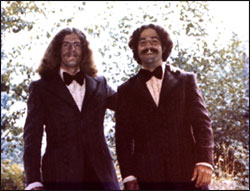
Hacky Sack co-inventors, Mike Marshall (left) and John Stalberger.
As is the premise with most successful notions, work and dedication are as important as timing. John Stalberger, the architect of the now global footbag movement, has capitalized on all three.
Stalberger, a stocky Texan with a vast sports background, was on vacation in 1972 when he met Mike Marshall at a local festival in Oregon City, Oregon. Stalberger, who was nursing an injured knee, became close friends with Mike Marshall. Marshall introduced John to a hobby he had learned from a Native American while in a military brig, due to an AWOL incident. Using a bean bag, the two kicked and bumped the object for hours in vain attempts at consecutive rallies. Stalberger found that rudimentary hobby, however obscure, to be excellent therapy for his injured knee, and the two became obsessed with their newfound hobby/exercise. When either would want to play, he would say, “Hey, let’s go hack the sack!” thus, the trade name Hacky Sack ® was born.
Stalberger and Marshall began experimenting with different shapes and sizes for their kicking object. One design was disc-like in shape, made of leather and filled with buttons. Another was made of denim from an old pair of jeans and filled with rocks.
 |
 |
 |
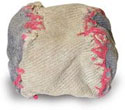 |
| This is John and Mike’s first square, beanbag style sack they made and hacked in 1972. |
In 1973 they experimented with a round shape, internal stitching, and a cover material robbed from Mike’s couch. |
Midway through 1973 the two inventors tested this thick cowhide leather pancake style for toughness. |
Found by Mike’s wife, Linda in their flower bed, this gem is believed to be their first attempt at the now classic 2-panel, baseball cut design from late in 1973. |
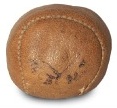
In 1974 this 2-panel, leather, internally machine sewn footbag broke new ground for John and Mike in terms of playing performance. Round was good.
It was not unusual to fill them with rice or seeds… but that led to problems when the footbags got wet, because eventually they would start to sprout. Eventually the two-panel baseball style design was developed. Just as their brainchild was about to break into the U.S. fun market, Mike Marshall suffered a heart attack in his sleep in 1975 and died at the age of 28.
With the increased encouragement of local merchants, friends and athletes, Stalberger’s new footbag model took on one more change. This time, plastic pellets proved to be more durable and gave the footbag a more consistent reaction while in play, again accentuating the natural flow.With added inspiration, Stalberger continued the quest to make their wish a reality. He found that by stressing the equal use of both sides of the body to control the footbag, and by restricting the touching of the footbag to only the feet and knees, the game could be used as an athletic or physical education training tool. At the same time, he found that a round design for the footbag created better kicking, along with more consistent angle-of-flight characteristics.
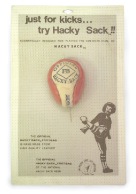
Between 1974 and 1977, a few thousand, hand-stitched 2-panel models were cranked out in Oregon to feed the craze beginning to smolder. In 1977, production began in earnest with the official packaged “made in Haiti” model (pictured above).
Stalberger, continuing to experiment with his sport, in 1978 invented the truly competitive version of the game known as footbag net. With this game Stalberger had formed a base for which tournament growth was to stand. His game was taking off!
In 1979 the U.S. Patent number 4151994 was granted Hacky Sack ® brand footbag, and in 1983 Wham-O, Inc. bought the North American manufacturing and distributing rights for a reported six-figure sum.
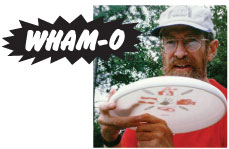
Wham-O’s sports/marketing director, Dan “Stork” Roddick was footbags’ first big corporate supporter.
Wham-O’s sports promotion director, Dan “Stork” Roddick quickly embraced their new Hacky Sack product and began promoting it along side their Frisbee disc as the two items shared a similar audience. For more than 10 year’s, Roddick’s annual budget funded hundreds of footbag promotions including regional, national and world competitions, school touring teams, physical education conventions and teacher in-service clinics, fairs and festivals and television commercials.
Today, millions of players throughout the world participate in the sport of footbag. It took both hard work and dedication, but Mike Marshall and John Stalberger made their own wish come true and, in the process, gave millions of us renewed faith in our feet!
FOOTBAG’S ANCIENT BEGINNINGS
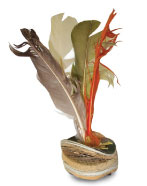
Chinese shuttlecock handmade from feathers and paper trimmed into a disc for a kicking base
The concept behind footbag – intercepting an object in flight and keeping it airborne by using all parts of the body except the hands and arms is not a new idea. Rather, as surprising as it may seem, the roots of our modern-day kicking game are to be found in ancient Eastern cultures.
According to one source, the first kicking game was developed by Chinese Emperor Hwang Ti in 2597 B.C.. Ti’s kicking object was constructed of leather, filled with hair, and was oblong in shape. This rudimentary kicking object was called a “mari,” and the game was Kemari. Kemari was not only enjoyed by the fun-seeking Chinese, but was utilized by the Emperor’s military for physical training and conditioning purposes.
In China, Japan and Korea, a game known as shuttlecock has been played for more than 2,000 years. This game utilizes a small, feathered, disc-like object to kick and pass between players. The various shuttlecocks used have had subtle differences. Most were constructed with flat bases that varied only slightly in thickness and were approximately 1-1/2 inches in diameter. In ancient Japan the game was also used to train the military, with officers forming clubs and standardizing rules. In Korea the game is played for practical reasons by shopkeepers and street vendors as a method of keeping their feet warm in cool weather!
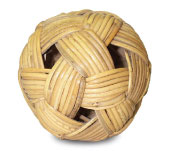
Original takraw ball handwoven of rattan (bamboo-like material) from Korea.
The national sport in the Malaysian countries is a foot-game that is over a thousand years old called sepak takraw. The kicking object, referred to as a takraw ball, is about 6 inches in diameter and made of woven rattan. Sepak takraw is played over a 5 foot high net on a playing court 44′ x 20′. As you will notice, sepak takraw is very similar to our sport’s competitive game of footbag net. Another ancient kicking game also happens to be the largest and most popular sport in the world, “soccer”! Known more commonly as football in every corner of the world except North America, soccer is played in more countries than the United Nations has members.
The Federation Internationale de Football Association (FIFA), the powerful athletic governing body that oversees the world’s most popular sport, estimates soccer is played by over 240 million players worldwide.

Vietnam shuttlecock handmade from feathers and a rice paper coiled kicking base.
Footbag is simply a modern version of these ancient kicking games, but it differs in two important respects: the object and the use of the upper body. As anyone who has ever picked up a footbag knows, the kicking object is considerably smaller, which makes control of it more challenging. And, with the exception of footbag freestyle, contact with the upper body is not allowed in regulation play. No other cultural kicking game has been found that prohibits the use of the upper body. The effect of this rule is that athletes are encouraged to use their neglected lower bodies.
While soccer-influenced countries practically have been reared on kicking, until recently most Americans have favored upper body sports (i.e., baseball, basketball, tennis, etc.). Learning to use both feet equally allows a person the opportunity to develop a sharp sense of total body synchronization and control, which can be of benefit in all physical activities, from dancing to playing tennis.
With thousands of years of venerable kicking history so well documented, the sport of footbag has settled into one of the most viable sports families in the world.




